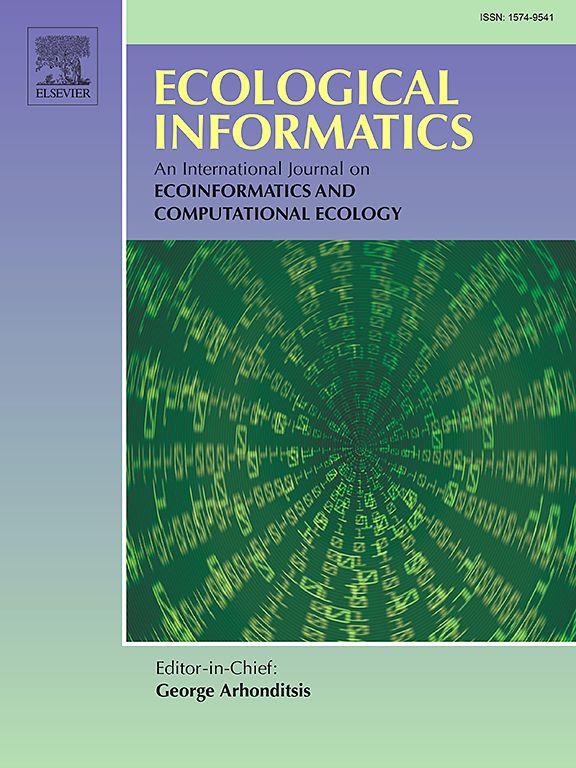A framework for predicting zoonotic hosts using pseudo-absences: the case of Echinococcus multilocularis
IF 5.8
2区 环境科学与生态学
Q1 ECOLOGY
引用次数: 0
Abstract
Identifying the host range of zoonotic parasites is challenging due to limited data and sampling biases. In particular, while more information exists for susceptible hosts, data on resistant species is extremely scant. Echinococcus multilocularis (Leuckart, 1863) (Cestoda: Taeniidae) is the causative agent of alveolar echinococcosis, one of the most significant food-borne zoonoses worldwide. Using data on susceptibility and competence of Holarctic cricetid and murid rodents, key intermediate hosts for E. multilocularis, we developed models to predict the likelihood of infection for any rodent species in the Holarctic. These models incorporated morphological and ecological characteristics and employed two approaches: Generalized Linear Models (GLM) and Presence-Unlabeled Learning (PU-L), a machine learning technique. To train the models, we defined pseudo-absences based on the bias in research effort. We compared the two algorithms and selected GLM as the most effective, using it to map potentially susceptible rodent species across phylogeny and geographic space. Predictions identified several potentially unreported hosts, suggesting that the current understanding of E. multilocularis host distribution may underestimate the true risk. The predicted richness of intermediate hosts peaked in Central-Eastern Europe, Western North America and Central Asia, while the ratio of predicted hosts to total rodent richness was highest in the northern latitudes and the Tibetan Plateau. The average temperature in the geographic range and range size emerged as the strongest predictors of host susceptibility. The workflow demonstrates promise for application to other host-parasite systems with unknown host ranges.
使用伪缺席预测人畜共患宿主的框架:多房棘球蚴的案例
由于数据有限和抽样偏差,确定人畜共患寄生虫的宿主范围具有挑战性。特别是,虽然有更多关于易感宿主的信息,但关于耐药物种的数据极其缺乏。多房棘球绦虫(Leuckart, 1863)(绦虫科:绦虫科)是肺泡棘球绦虫病的病原体,是世界上最重要的食源性人畜共患病之一。利用全北极蟋蟀和鼠型啮齿动物的易感性和能力数据,我们建立了模型来预测全北极任何啮齿动物物种感染的可能性。这些模型结合了形态和生态特征,并采用了两种方法:广义线性模型(GLM)和无标记存在学习(PU-L),一种机器学习技术。为了训练模型,我们根据研究工作中的偏差定义了伪缺席。我们比较了这两种算法,并选择GLM作为最有效的算法,使用它来绘制跨系统发育和地理空间的潜在易感啮齿动物物种。预测确定了几个潜在的未报告的宿主,这表明目前对多房绦虫宿主分布的理解可能低估了真正的风险。中欧、东欧、北美西部和中亚的预测宿主丰富度最高,北纬地区和青藏高原的预测宿主与总丰富度之比最高。地理范围内的平均温度和范围大小是宿主易感性的最强预测因子。该工作流程有望应用于其他宿主范围未知的宿主-寄生虫系统。
本文章由计算机程序翻译,如有差异,请以英文原文为准。
求助全文
约1分钟内获得全文
求助全文
来源期刊

Ecological Informatics
环境科学-生态学
CiteScore
8.30
自引率
11.80%
发文量
346
审稿时长
46 days
期刊介绍:
The journal Ecological Informatics is devoted to the publication of high quality, peer-reviewed articles on all aspects of computational ecology, data science and biogeography. The scope of the journal takes into account the data-intensive nature of ecology, the growing capacity of information technology to access, harness and leverage complex data as well as the critical need for informing sustainable management in view of global environmental and climate change.
The nature of the journal is interdisciplinary at the crossover between ecology and informatics. It focuses on novel concepts and techniques for image- and genome-based monitoring and interpretation, sensor- and multimedia-based data acquisition, internet-based data archiving and sharing, data assimilation, modelling and prediction of ecological data.
 求助内容:
求助内容: 应助结果提醒方式:
应助结果提醒方式:


